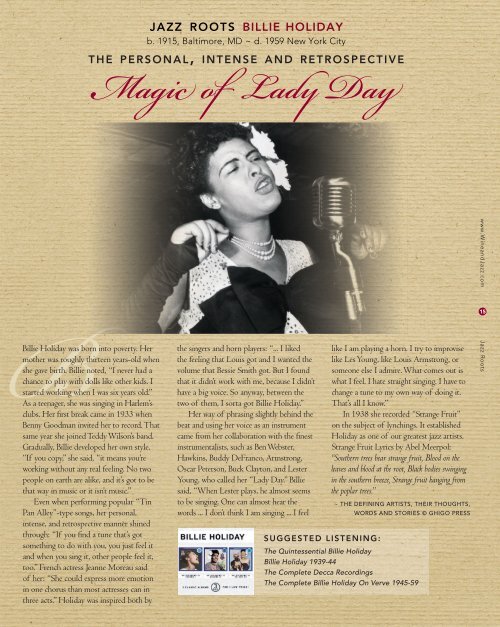You also want an ePaper? Increase the reach of your titles
YUMPU automatically turns print PDFs into web optimized ePapers that Google loves.
JAZZ ROOTS BILLIE HOLIDAY<br />
b. 1915, Baltimore, MD ~ d. 1959 New York City<br />
T<br />
Magic<br />
H E PERSONAL,<br />
of<br />
INTENSE<br />
Lady<br />
AND RETROSPECTIVE<br />
Day<br />
www.WineandJazz.com<br />
15<br />
Billie Holiday was born into poverty. Her<br />
mother was roughly thirteen years-old when<br />
she gave birth. Billie noted, “I never had a<br />
chance to play with dolls like other kids. I<br />
started working when I was six years old.”<br />
As a teenager, she was singing in Harlem’s<br />
clubs. Her first break came in 1933 when<br />
Benny Goodman invited her to record. That<br />
same year she joined Teddy Wilson’s band.<br />
Gradually, Billie developed her own style.<br />
“If you copy,” she said, “it means you’re<br />
working without any real feeling. No two<br />
people on earth are alike, and it’s got to be<br />
that way in music or it isn’t music.”<br />
Even when performing popular “Tin<br />
Pan Alley”-type songs, her personal,<br />
intense, and retrospective manner shined<br />
through: “If you find a tune that’s got<br />
something to do with you, you just feel it<br />
and when you sing it, other people feel it,<br />
too.” French actress Jeanne Moreau said<br />
of her: “She could express more emotion<br />
in one chorus than most actresses can in<br />
three acts.” Holiday was inspired both by<br />
the singers and horn players: “... I liked<br />
the feeling that Louis got and I wanted the<br />
volume that Bessie Smith got. But I found<br />
that it didn’t work with me, because I didn’t<br />
have a big voice. So anyway, between the<br />
two of them, I sorta got Billie Holiday.”<br />
Her way of phrasing slightly behind the<br />
beat and using her voice as an instrument<br />
came from her collaboration with the finest<br />
instrumentalists, such as Ben Webster,<br />
Hawkins, Buddy DeFranco, Armstrong,<br />
Oscar Peterson, Buck Clayton, and Lester<br />
Young, who called her “Lady Day.” Billie<br />
said, “When Lester plays, he almost seems<br />
to be singing. One can almost hear the<br />
words ... I don’t think I am singing ... I feel<br />
like I am playing a horn. I try to improvise<br />
like Les Young, like Louis Armstrong, or<br />
someone else I admire. What comes out is<br />
what I feel. I hate straight singing. I have to<br />
change a tune to my own way of doing it.<br />
That’s all I know.”<br />
In 1938 she recorded “Strange Fruit”<br />
on the subject of lynchings. It established<br />
Holiday as one of our greatest jazz artists.<br />
Strange Fruit Lyrics by Abel Meerpol:<br />
“Southern trees bear strange fruit, Blood on the<br />
leaves and blood at the root, Black bodies swinging<br />
in the southern breeze, Strange fruit hanging from<br />
the poplar trees.”<br />
~ THE DEFINING ARTISTS, THEIR THOUGHTS,<br />
WORDS AND STORIES © GHIGO PRESS<br />
SUGGESTED LISTENING:<br />
The Quintessential Billie Holiday<br />
Billie Holiday 1939-44<br />
The Complete Decca Recordings<br />
The Complete Billie Holiday On Verve 1945-59<br />
Jazz Roots


